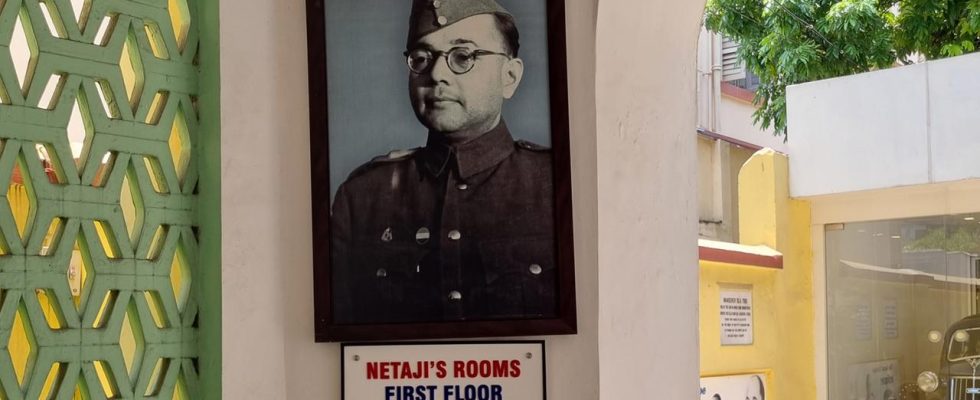Subhas Chandra Bose wanted to achieve India’s independence by force. He fell out with Gandhi and made a pact with Hitler. Today, Prime Minister Modi wants to make him a national hero.
The red curtain slowly slides aside to reveal his statue: Subhas Chandra Bose, fighter for Indian independence. Over eight meters high, made of black granite. The two and a half kilometer long boulevard between the Presidential Palace and the Arc de Triomphe in New Delhi is festively illuminated on this September evening last year. The message: India wants to leave its colonial past behind – 75 years after independence. In his speech, Prime Minister Narendra Modi speaks of Bose as the “national leader”: “In the days of slavery there stood a statue of the representative of British rule. Today, with the statue’s installation in the same place, the country also has the life of a modern and strong of India.”
According to Modi, for too long India has ignored this great hero of independence – a dig at the opposition, the Congress Party. For decades, she honored the legacy of Mahatma Gandhi and his vision of civil disobedience and non-violent protest. Subhas Chandra Bose, on the other hand, saw fighting the British colonial power violence as the means of choice.
Bose meets Hitler and forms a Freikorps
Bose was born in 1897 south of Calcutta, today Kolkata. His father wanted him to pursue a career in the Indian Civil Service, the higher civil service of British India. But Bose has other plans. At 24 he joined the Indian Independence movement led by Mahatma Gandhi and the Indian National Congress. Bose rises quickly. He is considered radical, vehemently demands immediate sovereignty for India, if necessary by force – in doing so he is in opposition to Gandhi.
In the early 1930s, Bose traveled to Europe and tried to persuade influential politicians to support the idea of Indian independence. In Vienna he is writing his book “The Indian Struggle” with the help of an assistant, Emilie Schenkl. They became a couple and married in 1937.
With the start of World War II, the British also enlisted Indian soldiers for combat. Bose is back in India and organizing a mass protest. He will be arrested. After a hunger strike, the British put him under house arrest in his family’s home. From there he can secretly escape. His escape takes him to Berlin.
In May 1942, Bose managed to arrange a meeting with Adolf Hitler. Meanwhile, thousands of Indian soldiers who fought for the British are in German captivity in a camp in Annaburg, south of Berlin. Hitler agrees to Bose founding a volunteer corps with these Indian soldiers: the “Legion Free India”.
Anita Bose Pfaff in front of a portrait of her father: she sees his fraternization with European fascists uncritically.
Death in Taiwan at the age of 48
Anita Bose Pfaff is the daughter of Bose and his wife Emilie Schenkl. The retired professor lives in Augsburg. She is a SPD member. Her husband sat for years in the Bundestag for the Social Democrats. How does she assess her father’s closeness to fascist leaders such as Hitler and Mussolini? According to Bose Pfaff, her father had no choice but to ally himself with Britain’s opponents: “Gandhi had called for the ‘Quit India Movement’. The entire leadership was in prison. The struggle for independence went no further.”
When the Germans invade Russia, Bose can no longer expect any support from them. But the Germans assure Bose that they will take him from Kiel on board a submarine through enemy waters towards ally Japan. In July 1943, Bose finally became commander of the Indian National Army in Singapore. More than 40,000 Indian soldiers were taken prisoner there by the Japanese. The newly formed Indian army marches towards India. But in April 1945, the British captured many soldiers.
In August of the same year, the Americans drop atomic bombs on Japan. Two days after Japan’s surrender, Bose boards a plane bound for Tokyo – with a stopover in Taiwan. The plane crashes there after taking off again. Bose died of burn injuries in a Taipei military hospital at the age of 48.
Bose’s great-nephew, Sugata Bose, is a history professor at Harvard. He sees the instrumentalization of his great-uncle in the present critical.
see relatives instrumentalization critical
Conspiracy theories are spreading among his supporters in the Indian national army as to whether he survived after all. Some suspect that India’s Prime Minister Modi is deliberately maintaining the mystery surrounding Bose. He and his Hindu nationalist party, the BJP, are repeatedly accused of dividing the country and allowing discrimination against the Muslim minority in particular. They aspire to the “Hidutva”, a nation primarily for Hindus.
Bose’s daughter Anita thinks it’s positive that Modi has set a souvenir for her father in the form of a statue in the middle of New Delhi: after all, Bose was very committed to India’s independence. “What I don’t like too much is that he’s being used as an instrument when it comes to some other political issues. Well, my father was certainly not on the same line as the BJP in terms of his entire political orientation. Yes, proud of India . But my father, which many people didn’t know very well either: he was a left-wing politician.”
It is largely unknown that Bose also advocated peaceful coexistence of religions and equality between men and women in his vision of a free India. His great-nephew Sugata Bose, a history professor at Harvard, deeply regrets this. At the same time, he fears “that the current regime is mainly emphasizing its military prowess: they are not doing enough to stop the spread of a poison, namely religious hatred,” he says. He’s sure Subhas Chandra Bose would have been very upset by this.

